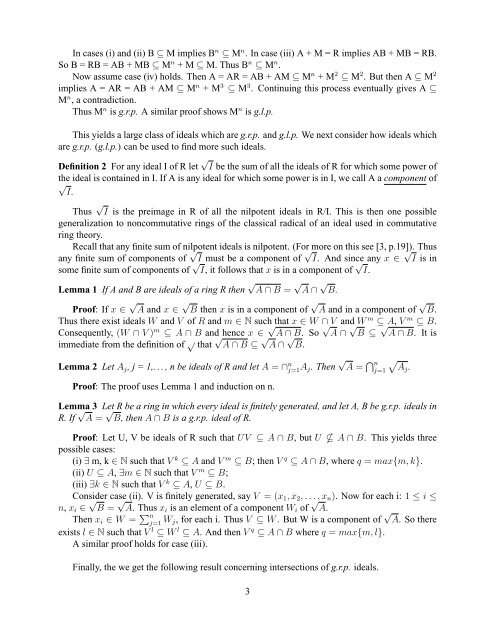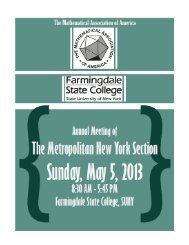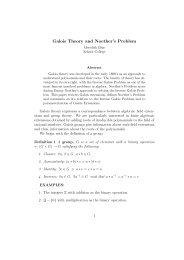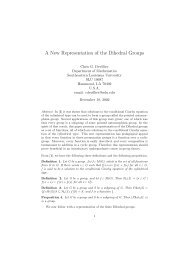Generalizations of Primary Ideals - MAA Sections
Generalizations of Primary Ideals - MAA Sections
Generalizations of Primary Ideals - MAA Sections
Create successful ePaper yourself
Turn your PDF publications into a flip-book with our unique Google optimized e-Paper software.
In cases (i) and (ii) B ⊆ M implies B n ⊆ M n . In case (iii) A + M = R implies AB + MB = RB.So B = RB = AB + MB ⊆ M n + M ⊆ M. Thus B n ⊆ M n .Now assume case (iv) holds. Then A = AR = AB + AM ⊆ M n + M 2 ⊆ M 2 . But then A ⊆ M 2implies A = AR = AB + AM ⊆ M n + M 3 ⊆ M 3 . Continuing this process eventually gives A ⊆M n , a contradiction.Thus M n is g.r.p. A similar pro<strong>of</strong> shows M n is g.l.p.This yields a large class <strong>of</strong> ideals which are g.r.p. and g.l.p. We next consider how ideals whichare g.r.p. (g.l.p.) can be used to find more such ideals.Definition 2 For any ideal I <strong>of</strong> R let √ I be the sum <strong>of</strong> all the ideals <strong>of</strong> R for which some power <strong>of</strong>the ideal is contained in I. If A is any ideal for which some power is in I, we call A a component <strong>of</strong>√IṪhus√I is the preimage in R <strong>of</strong> all the nilpotent ideals in R/I. This is then one possiblegeneralization to noncommutative rings <strong>of</strong> the classical radical <strong>of</strong> an ideal used in commutativering theory.Recall that any finite sum <strong>of</strong> nilpotent ideals is nilpotent. (For more on this see [3, p.19]). Thusany finite sum <strong>of</strong> components <strong>of</strong> √ I must be a component <strong>of</strong> √ I. And since any x ∈ √ I is insome finite sum <strong>of</strong> components <strong>of</strong> √ I, it follows that x is in a component <strong>of</strong> √ I.Lemma 1 If A and B are ideals <strong>of</strong> a ring R then √ A ∩ B = √ A ∩ √ B.Pro<strong>of</strong>: If x ∈ √ A and x ∈ √ B then x is in a component <strong>of</strong> √ A and in a component <strong>of</strong> √ B.Thus there exist ideals W and V <strong>of</strong> R and m ∈ N such that x ∈ W ∩ V and W m ⊆ A, V m ⊆ B.Consequently, (W ∩ V ) m ⊆ A ∩ B and hence x ∈ √ A ∩ B. So √ A ∩ √ B ⊆ √ A ∩ B. It isimmediate from the definition <strong>of</strong> √ that √ A ∩ B ⊆ √ A ∩ √ B.Lemma 2 Let A j , j = 1,. . . , n be ideals <strong>of</strong> R and let A = ∩ n j=1A j . Then √ A = ⋂ nj=1√Aj .Pro<strong>of</strong>: The pro<strong>of</strong> uses Lemma 1 and induction on n.Lemma 3 Let R be a ring in which every ideal is finitely generated, and let A, B be g.r.p. ideals inR. If √ A = √ B, then A ∩ B is a g.r.p. ideal <strong>of</strong> R.Pro<strong>of</strong>: Let U, V be ideals <strong>of</strong> R such that UV ⊆ A ∩ B, but U A ∩ B. This yields threepossible cases:(i) ∃ m, k ∈ N such that V k ⊆ A and V m ⊆ B; then V q ⊆ A ∩ B, where q = max{m, k}.(ii) U ⊆ A, ∃m ∈ N such that V m ⊆ B;(iii) ∃k ∈ N such that V k ⊆ A, U ⊆ B.Consider case (ii). V is finitely generated, say V = (x 1 , x 2 , . . . , x n ). Now for each i: 1 ≤ i ≤n, x i ∈ √ B = √ A. Thus x i is an element <strong>of</strong> a component W i <strong>of</strong> √ A.Then x i ∈ W = ∑ nj=1 W j, for each i. Thus V ⊆ W . But W is a component <strong>of</strong> √ A. So thereexists l ∈ N such that V l ⊆ W l ⊆ A. And then V q ⊆ A ∩ B where q = max{m, l}.A similar pro<strong>of</strong> holds for case (iii).Finally, the we get the following result concerning intersections <strong>of</strong> g.r.p. ideals.3
















